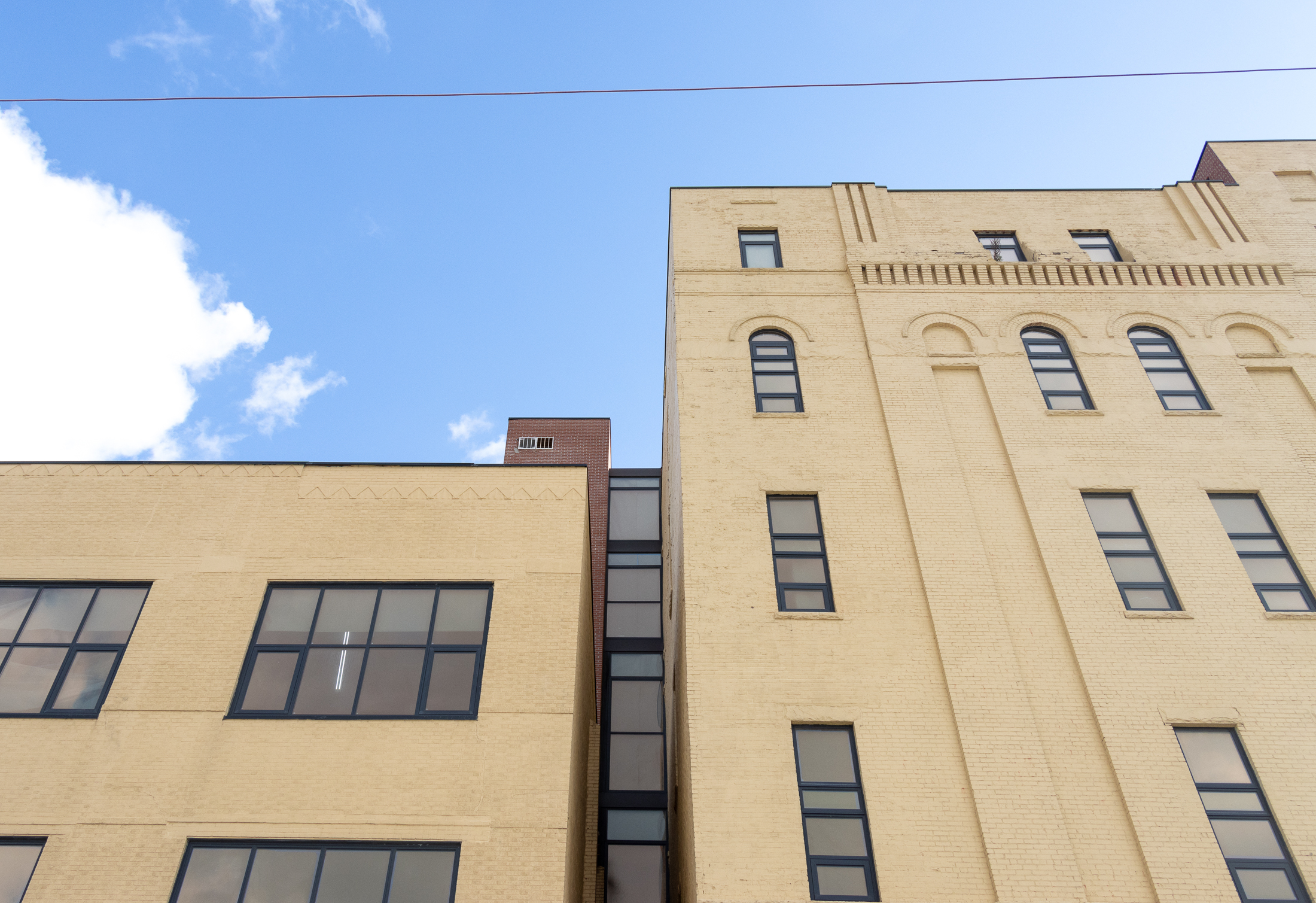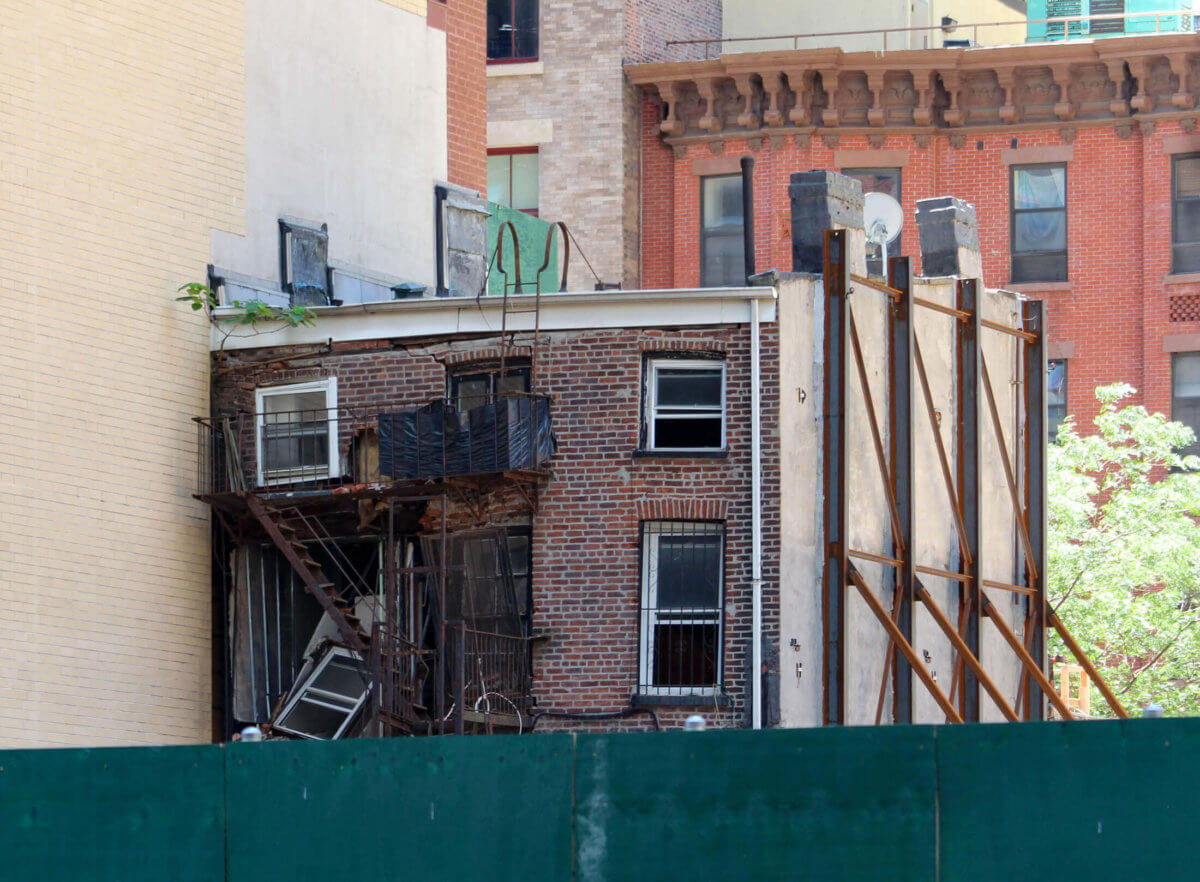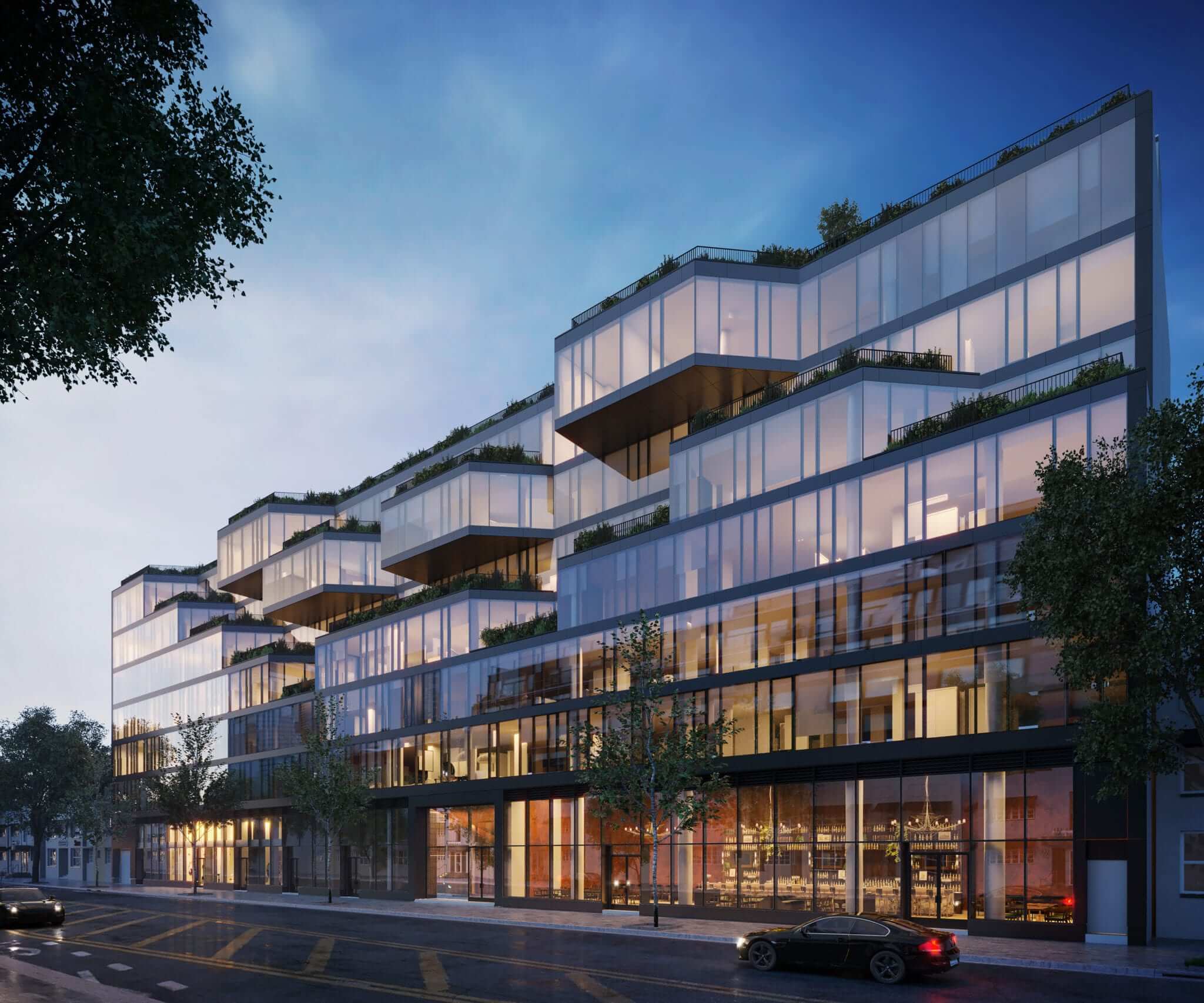Following Thomson Avenue Through LIC
A dizzying display of industrial and architectural might, on display above, distracts the eye from the subject of this post. Empire State, Chrysler, the entire shield wall of Manhattan – even the sapphire spire which distinguishes modern Long Island City – are all screaming for attention. At the sapphire tower’s base is a white building,…

A dizzying display of industrial and architectural might, on display above, distracts the eye from the subject of this post.
Empire State, Chrysler, the entire shield wall of Manhattan – even the sapphire spire which distinguishes modern Long Island City – are all screaming for attention. At the sapphire tower’s base is a white building, a former printing plant and later an Eagle Electric factory, which has long been converted over to luxury condominiums and is known as the Arris Lofts. At the bottom of the shot is Skillman Avenue, and the tracks of the Sunnyside Yard A show a train transiting along. In the midst of all this manifest wealth and ambition, it is easy to overlook the subject of today’s post. The lower right hand corner of the shot depicts a viaduct structure, one which allows trains to pass beneath a vehicular roadway which it supports.
An enormous concrete and steel bridge, 500 feet long and 100 feet wide, it is hidden in plain sight.
That’s the Thomson Avenue Viaduct.
From 1877′s “Long Island and where to go!!: A descriptive work compiled for the Long R.R. Co.“, courtesy Google Books:
Long Island City is the concentrating point upon the East river, of all the main avenues of travel from the back districts of Long Island to the city of New York. The great arteries of travel leading from New York are Thomson avenue, macadamized, 100 feet wide, leading directly to Newtown, Jamaica and the middle and southern roads on Long Island, and Jackson avenue, also 100 feet wide, and leading directly to Flushing, Whitestone and the northerly roads.
Long Island City is also the concentrating point upon the East river, of the railway system of Long Island.
The railways, upon reaching the city, pass under the main avenues of travel and traffic, and not upon or across their surface.
To begin with, lets start with the end. Thomson Avenue disappears into the modern street grid when it is rudely interrupted by and becomes Queens Boulevard. This is the actual slam bang intersection where the “automobile city” of the 20th century meets the “locomotive city” of the 19th, at the intersection where Thomson avenue meets Queens Boulevard and Van Dam Street.
The “Great Machine” slithers past Thomson, and hurtles eastward along the more modern thoroughfare.
From Wikipedia: “Queens Boulevard was built in the early 20th century to connect the new Queensboro Bridge to central Queens, thereby offering an easy outlet from Manhattan. It was created by linking and expanding already-existing streets, such as Thomson Avenue and Hoffman Boulevard, stubs of which still exist.”
Thomson adjoins Jackson Avenue on the northern side of its run, where their junction forms the so called “Court Square,” where the 1990 vintage Citigroup structure might be noticed. There used to be a hospital where the colossus now stands.
Overwhelming and out of character with its surroundings, it is the tallest structure on Long Island, and the 56th highest building in New York City – if you’re impressed by that sort of thing.
From Wikipedia:
One Court Square, also known as the Citigroup Building, is a 50-story (209.1 meters or 686 feet) office tower in Long Island City, Queens just outside of Manhattan in New York City. It was completed in 1990 by Skidmore, Owings & Merrill LLP for Citigroup. The tower is tallest in New York City outside Manhattan, and the tallest building on Long Island. WNYZ-LP, also known as Pulse87.7 broadcasts from the top of this building.
Across the street is why they call it Court Square, and a historic building discussed in this Brownstoner Queens post is found.
Moving in an easterly direction from Court Square, Thomson finds another connection to the automobile city, as one of the off ramps for the upper level of the Blackwell’s Island… Queensboro… Ed Koch… Bridge empties out here, allowing tens of thousands of vehicles to vomit onto Thomson’s parabola every day.
From “Bulletin, Volumes 9-10 By Building Trades Employers’ Association“, courtesy Google Books:
The rapid progress being made in the grading of Sunnyside yard in Long Island City, the future great terminal of the Pennsylvania Railroad system in New York, and the rapid construction of the eight massive viaducts to provide for the highway and railroad crossings, insure the completion of that section of the great undertaking early next fall.
The most massive of the overhead highway crossings is the Thomson Ave. steel viaduct, 100 feet in width and 500 feet in length, passing over the network of tracks of the Long Island and Pennsylvania Railroads at a height of 30 feet. The Queensboro Bridge extension viaduct, crossing diagonally to the street system of Long Island City, but at right angles to the railroad, is 80 feet in width, and has massive steel girders. The Thomson Ave. crossing, which will be completed next month, and the bridge extension will provide for the traffic over the main arteries of travel, extending through the borough from north to south.
On the side streets which dead end off of Jackson Avenue, like Dutch Kills or Queens or Purves Streets, one can gain an appreciation for the altitude of this Thomson Avenue Viaduct. These roadway artifacts used to proceed through what is now the rail yard, and the historical record is full of lawsuits brought by LIC residents against the Pennsylvania Rail Road or Long Island Railroad companies for damages based on the grade situation or for “dead ending” their street.
These lawsuits detail and define the complicated questions of who owns what around and above the yards. Then – however – as now, you can’t fight City Hall if it wants to do something in your neighborhood.
From 1913′s “2 years transportation progress, Volume 140“, courtesy Google Books:
“Perpetual easement or easements for the rights to continue and maintain the said viaducts or bridges over the following streets or avenues as nowlaid out or proposed: and will thereby grant to the city a perpetual easement or easements sufficient for the use and control by the city of the said viaducts and bridges for the purpose of police regulation and other control contemplated by the city ordinances for the care of streets or highways, excepting and reserving, however, to the said companies the right to construct and maintain, at its or their own expense, such connections between the said viaducts or bridges, or any of them, and the property of the said companies, as shall not interfere with the use of the said viaduets or bridges for street purposes.”
Then are specified several viaducts, and as to the one over Thomson avenue it is said:
“The said viaduct or bridge over the proposed Sunnyside Yard on the line of Thomson avenue, hereinbefore in paragraph 1C, set forth, including the right to the city to increase, at its own expense and without interfering with the operation of the said Sunnyside Yard, the width of said viaduct to beone hundred feet.”
The intention of the companies was to enlarge the terminal laterally by acquiring from! the city title to the land in the closed streets wherever necessary, and by acquiring the lands abutting thereon from private owners. To do this it was necessary to close the streets across the right of way as broadened, so that the companies could have the fee and possession thereof for railroad purposes. But in some instances, and among them at Thomson avenue, in the place of the portion of the street closed and agreed to be sold a viaduct over the yard was provided and built, and it was necessarily so high over the tracks that the grade of the avenue at either end was necessarily raised to meet it. In other words, over the space where the avenue was obliterated and its bed agreed to be sold a bridge was built, and the abandoned portion made a part of the terminal facilities.
The Sunnyside Yard tends to insulate Long Island City from the rest of western Queens, forcing its residents and businesses to pass through narrow or crowded choke points when leaving or entering the locale. The landward vehicular passages along the East River are defined by Queensboro and the Midtown Tunnel, while the southern ridge (Skillman Avenue) that overlooks the yard leads to residential Sunnyside. The Yard complex allows locomotive access to the both the East River tunnels and to the New York Connecting Railroad, which links Long Island rail to the rest of the continent via the Hell Gate Bridge.
Sunnyside Yard continues all the way to Woodside, and sits on an astounding 8,500 foot plot which consumes 192 acres and offers an unbelievable 25.7 miles of track.
The viaducts which cross the yards — Hunters Point Avenue, Thomson Avenue, Queens Boulevard are all orientated in a mostly easterly direction, while the 35th Street or Honeywell Bridge, and the 39th Street or Harold Avenue Bridge at Steinway Street offer rare and spread out pinch-points of north south egress across the facility. The businesses which set up shop around Sunnyside Yard in the early 20th century didn’t much care about auto traffic, they were part of the locomotive city and were here for the rail connections.
Check out this Brownstoner Queens post about the yard, which offers an aerial perspective.
From 1913′s “Greater New York: bulletin of the Merchants’ Association of New York, Volume 2,” courtesy Google Books:
After luncheon, which was held in the cosy quarters of the Queens Chamber of Commerce on the Bridge Plaza, Long Island City, the party were taken on an automobile drive of about fifty miles, covering the principal points of Industrial interest in Queens.
The first stop was made on Diagonal Street which crosses the Long Island Railroad yards. From this point it is possible to see all the features of the industrial development in that part of Queens, especially the development of the Degnon Terminal Company and the new factory of the Loose-Wiles Biscuit Company.
The party then proceeded along Thompson Avenue to Newtown Creek, passing some of the largest factories in Queens, and also the most important industries in New York City, such as the Nichols Copper Company, the General Chemical Company, the National Enameling and Stamping Company, the General Vehicle Company, which is just erecting a large new building, and the Brunswick-Balke-Collender Company.
The naming of Thomson Avenue has always been a bit of a mystery for me.
Skillman Avenue, for instance, was named for a farmer that supported the British during the American Revolution and whose lands were confiscated by the victorious rebels (much like DeLancey over in Manhattan). Apparently, there were one or two LIRR and or Pennsylvania RR executives named Thompson – certain older documents refer to this road as “Thompson Avenue” but this is a common typographic error which favors the more widespread surname.
There was a Thomson that was an important member of the Queens Chamber of Commerce and LIC community during the 1920′s – but the street dates back to the beginnings of Long Island City and must be named for someone from earlier times.
From 1910′s “New York tunnel extension, the Pennsylvania railroad: description of the work and facilities, Volume 2“, courtesy Google Books:
Originally, a swamp of 40 acres extended from the present location of Honeywell Street and Jackson Avenue to Thomson Avenue, and comprised a portion of the required Yard area; the remaining 168 acres within that area was rolling ground from 10 to 70 ft. above the swamp. Upon this high ground there were 246 buildings of all kinds, and these were purchased and torn down or removed. A view of the swamp in the early stages of the work is shown by Fig. 1, Plate XLV. A vegetable growth, of the nature of peat, from 1 to 4 ft. in thickness, formed the surface of the swamp, except in the bed of Dutch Kills Creek; beneath this there was a layer of mud, and in the bed of the stream a blue-black clay of the consistency of putty. As this muck and clay would move under the pressure of the filling over it, and produce waves of considerable height, it was specified in the contract that a blanket of earth about 4 ft. thick should be first placed over this part of the Yard area, in order to prevent this wave formation. This proved efficacious, except in one or two places, where, owing to unusual depth of filling, the wave formation broke through this covering and rose to such a height as to require excavation of the peat, muck, and mud, in order to secure proper track foundations. In the bed of Meadow Street, where the embankment was very high, the crest of one of the mud waves rose to an elevation of 28 ft. above the swamp.
Newtown Creek Alliance Historian Mitch Waxman lives in Astoria and blogs at Newtown Pentacle.
















Mitch, I love you and your posts to death. Your work is excellent. I have a sincere question though:
Why say it’s the tallest tower “on Long Island.”
I understand that Brooklyn, Queens, and LI form a contiguous land mass. But to call these four counties “Long Island” seems weird in 2014. “Tallest outside of Manhattan” means something. But “tallest in Long Island” is rather arbitrary.
So many folks here who grew up elsewhere are already confused. And yes, I’m one of those who gets annoyed when I hear people refer to Manhattan as “the city.” Right – let’s take a nice stroll down Roosevelt Ave. from Woodside to Corona and tell me that’s the fuckin suburbs.